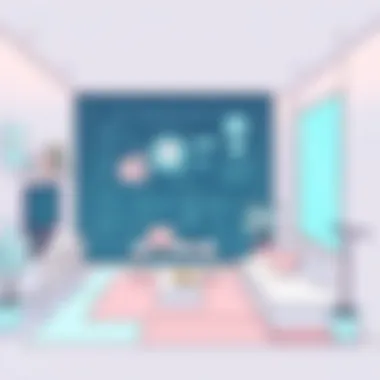Maximize Your Design Potential with Floor Plan Tools


Intro
In today’s fast-paced world, where designing spaces efficiently and effectively is paramount, floor plan creator websites have carved out a significant niche. These online tools are often the go-to for both amateur designers and seasoned professionals looking to visualize their ideas. Yet, with a plethora of options available, how do you navigate this digital landscape? This article aims to bridge that gap by empowering you with insights into key functionalities, user needs, and essential tips that enhance your design experience.
Whether you’re a tech-savvy individual embarking on a renovation project, or a business professional wanting to create a compelling presentation, understanding the best floor plan creator websites can save you time and money. The significance of choosing the right platform cannot be overstated, as it influences not only the creativity of your designs but also their accuracy and efficiency.
We’ll explore how these tools cater to varying user requirements, compare popular platforms, and delve into market trends that shape this industry. By the end of this guide, you’ll feel equipped to select a tool that aligns with your specific design needs.
Software Needs Assessment
Identifying User Requirements
Before diving into the sea of floor plan creators, it's crucial to first assess what you specifically need from these platforms. Are you looking to design a personal space, like a cozy home layout, or do you have professional requirements, such as drafting plans for a commercial office? Knowing the end goal helps narrow down the options considerably.
Consider aspects like:
- Intuitive Interface: Do you want something simple to navigate or are you willing to tackle a steeper learning curve for advanced features?
- Feature Set: Do you need 3D rendering, or simple 2D layouts will suffice? What about collaboration tools, integrations, or mobile access?
- Budget: Are free tools sufficient or do you require the premium options for a more comprehensive experience?
Taking the time to reflect on these factors could save a lot of headaches down the road.
Evaluating Current Software Solutions
Once you’ve identified your requirements, the next step is to weigh the current software solutions available. Do thorough research to see how well each tool aligns with your needs. Look for customer reviews, and don’t shy away from using trial versions to get a feel for the software.
Some popular tools include:
- SketchUp: Known for its powerful 3D modeling capabilities, it is suitable for more technical designs.
- Floorplanner: Offers a more straightforward approach for those who favor ease of use.
- RoomSketcher: Including both an app and a desktop version, it caters well to casual users as well as professionals.
An evaluation can quickly spotlight which platforms stand tall in terms of usability and features tailored to your specific situation.
Data-Driven Insights
Market Trends Overview
The market for floor plan creation is booming as more designers discover the value of these tools. Recent trends indicate a shift towards platforms that prioritize collaboration and integration. Many modern tools offer options to share designs effortlessly across social media or collaborate in real-time on a project. The growing importance of user-friendly mobile access has also spiked, with more people seeking to work on designs from various devices.
Performance Metrics
When selecting a floor plan creator, it’s vital to consider its performance metrics. Look for:
- User Satisfaction Ratings: These can often be found on reputable review sites or company websites.
- Speed and Reliability: A tool that takes ages to render designs can hamper creativity.
- Tech Support Availability: Responsive customer support can be a lifesaver in times of need.
Incorporating these aspects into your assessment ensures your investment offers not just immediate benefits, but long-term satisfaction.
Choosing a floor plan creator website is not just about the bells and whistles; it's about finding the tool that best serves your unique needs.
Understanding Floor Plan Creator Websites
In the realm of design, aesthetics matter, but so does functionality. Understanding floor plan creator websites is essential for anyone looking to transform ideas into tangible layouts, be it for a home, office, or any other space. These platforms enable users to visualize their designs clearly and accurately, making the process not just simpler but significantly more efficient.
When thinking about floor plans, one must consider the myriad tasks involved—from conceptualizing spaces to arranging furniture. The importance of a floor plan creator lies in its ability to streamline these processes. Users can manipulate dimensions, adjust layouts, and experiment with designs almost effortlessly, eliminating the risk of costly errors that might arise from manual drafting.
What Is a Floor Plan Creator?
A floor plan creator is essentially a digital tool that allows users to draw and edit floor plans with precision. Think of it as a sophisticated drawing app but tailored specifically for space planning. It empowers architects, interior designers, and even everyday homeowners to engage with their space more visually. The beauty of such platforms comes from their intuitive interfaces, which often offer a chance to visualize entire rooms in 3D. This not only helps in understanding scale but also in planning how each room will function.
Types of Floor Plan Creator Websites
Different platforms cater to different needs. Understanding these categories strengthens your capability to select the right tool.
Web-based Applications
Web-based applications have gained ground due to their accessibility. You don’t need to install heavy software on your computer; just fire up a web browser and you’re good to go. This kind of floor plan creator can be used on various devices, making it a versatile choice for many users. One of the key characteristics is that many of these tools are cloud-based, meaning your designs and projects are backed up automatically, reducing the likelihood of data loss.
However, while being web-based is convenient, it can also present some challenges, such as reliance on a stable internet connection. Performance might lag occasionally, and accessing complex features may require a more substantial connection, which can be a drawback when working on detailed projects.
Mobile Applications
Mobile applications offer portability, allowing you to work on designs wherever you go. The key characteristic here is quite straightforward: they are designed for touch interfaces, making them user-friendly for on-the-go adjustments. You can sketch out ideas during a meeting or tweak designs while waiting in line.


The unique feature in many mobile applications is the ability to use augmented reality (AR) to visualize how pieces fit within your actual space. However, a potential disadvantage is limited functionality compared to desktop software; mores expansive tools might be absent. Still, for many casual users, this trade-off is often worth it.
Desktop Software
Desktop software remains a popular choice among professional designers. These applications tend to be more robust, packed with features suited for intricate designs. They often provide greater flexibility in terms of customization and functionalities. The key characteristic is that these tools can handle more complex models without the slowdown sometimes experienced with online platforms.
One unique feature of desktop software is the capacity to work offline, an immense advantage for professionals operating in environments with unreliable internet. Though they may have a steeper learning curve owing to their complexity, they often yield stunningly detailed results that can impress clientele. However, accessibility becomes an issue as these programs are usually licensed, meaning they come with a cost, which might be prohibitive for casual users.
In summary, choosing the right type of floor plan creator website primarily hinges on your specific needs, level of expertise and the contexts within which you will be working. Each of these tools serves a distinct purpose and can elevate the quality and efficiency of design projects.
Key Features of Floor Plan Creator Websites
The effectiveness of floor plan creator websites is often determined by their features. These platforms can vary widely, but certain key characteristics consistently enhance user experience and functionality. Understanding these features can make the difference between a tool that merely serves its purpose and one that empowers designers to create, collaborate, and visualize with confidence. In this section, we will break down essential components, focusing on user interface, design tools, and collaboration aspects that elevate the floor planning process.
User Interface and Experience
Intuitive Navigation
When users sit down to create a floor plan, the last thing they want to encounter is a confusing interface. Intuitive navigation is like a clear map in a dense forest; it guides users smoothly through the tool without added frustration. A standout characteristic of many top-tier floor plan creators is the simplicity of movement through their features. Everything should be where you expect it to be—tools for drawing, editing, and customizing layouts should be accessible from a central dashboard.
A unique feature of intuitive navigation might include on-screen prompts or tooltip hints which assist users as they navigate the software. This is especially effective for those who may not be tech-savvy. However, a potential downside is that overly simplified interfaces can sometimes lead to limitations in deeper functionalities for advanced users.
Customization Options
The hallmark of any good floor plan creator is its ability to be molded to the user's specific needs. Customization options allow users to tailor their design experience according to personal or project requirements. This includes choosing different wall types, colors, and furniture styles, creating an environment that resonates with the end-user's vision.
The key characteristic here is flexibility—how many attributes can you tweak? In this article, we emphasize tools with a wide range of customization options, as they aid in expressing unique design ideas. Unique features, such as the ability to upload personal textures or styles, can enhance this experience further. However, an abundance of choices can also overwhelm some users if not presented clearly.
Design Tools and Features
Drag-and-Drop Functionality
A crowd favorite among floor plan creation aficionados is the drag-and-drop functionality. This feature streamlines the process of laying out designs, allowing users to move and arrange elements effortlessly. One significant aspect of this feature is that it transforms what could be a tedious task into an enjoyable creative exercise.
This functionality is particularly popular because it provides a tactile way of shaping your space. Users can see changes instantaneously, making adjustments in real-time. However, some users might find that on less powerful devices, drag-and-drop can be sluggish, somewhat impeding the planning process.
3D Visualization
What good is a floor plan if you can’t visualize it in three dimensions? 3D visualization is crucial in floor plan creator websites, making it possible to understand how a space will look and feel before physical alterations are made. The standout characteristic here is realism; many platforms leverage sophisticated rendering technologies that produce detailed and visually appealing models of the design.
This allows users to walk through their plans in a way that flat designs simply do not allow. A unique twist may include the ability to view designs in virtual reality mode, offering an immersive experience that can inform design choices. The downside, however, is that high-performance graphics can demand more from hardware, which can alienate users on outdated systems.
Collaboration and Sharing Capabilities
Cloud-Based Storage
With the growing necessity for remote collaboration, cloud-based storage has become a non-negotiable feature in floor plan creator websites. It allows users to save, access, and share their projects from anywhere. The primary advantage here is accessibility; you’re no longer bound to a single workstation or device, fostering a more agile working environment.
The unique aspect of cloud storage often includes backup features that safeguard years of work against accidental loss. However, potential downsides could involve concerns about data security and occasional reliance on internet access, which might not be stable everywhere.
Project Sharing Tools
It’s not just about creating a floor plan; it’s also about sharing it effectively with clients or team members. Project sharing tools enhance collaboration by enabling seamless distribution of floor plans as links or files with varied access levels. This is a game-changer, especially when working on complex projects where multiple individuals contribute.
The hallmark of effective sharing tools lies in their ease of use. Providing options for comments or suggestions directly on the floor plans can offer valuable feedback without confusion. However, without proper controls, users may find their designs vulnerable to unwanted edits or miscommunication.
The right features in a floor plan creator can substantially enhance your design experience, saving you both time and effort while ensuring your ideas come to life exactly as envisioned.
Benefits of Using Floor Plan Creator Websites
When it comes to designing spaces, whether for personal projects or professional endeavors, utilizing floor plan creator websites offers a myriad of advantages. These platforms not only streamline the design process but also enhance accuracy and overall efficiency. In this section, we will dive into the major benefits, emphasizing how these tools can transform the way users approach spatial design.
Enhanced Design Accuracy
One of the standout benefits of using floor plan creator websites is the significant boost in design accuracy. The sophisticated tools available on these platforms allow users to create intricate designs with precision.
Consider this: with traditional methods like sketching or manual drafting, even the most skilled designer can run into miscalculations. But with digital tools, measurements are often inputted directly, ensuring that the dimensions are precise and proportional. This translates to a reduction in errors that might arise from manual measurements, leading to a more reliable design.
Moreover, many floor plan creator websites come equipped with built-in measurement tools and guidelines, assisting users in understanding spatial relationships. These features help in retaining consistency throughout the design process.
- Users can overlay grids or guides to align elements accurately.
- Automatic adjustments ensure proper scales, even when resizing.
- Layers can be utilized to separate various design aspects for clarity.


Having a design that is accurate not only saves time but also resources. A precise floor plan can minimize the need for costly alterations during later stages of the development process, thereby keeping budgets in check.
Time Efficiency in Project Development
In today's fast-paced world, time is often of the essence. Floor plan creator websites substantially improve time efficiency during project development. When designers can implement rapid iterations and modifications, they can easily explore multiple layouts without starting from scratch each time.
By providing predefined templates and drag-and-drop features, these websites enable users to visualize their ideas quickly. For instance, a user can test various room configurations in a matter of minutes—something that would take hours or days if done manually. This agility fosters greater creativity and innovation, allowing users to experiment with designs freely.
- Collaboration features enable simultaneous work with teams, speeding up the feedback loop.
- Instant sharing tools allow for quick updates and stakeholder involvement.
- Accessibility on multiple devices means designers can work on-the-go, making the best use of idle time.
The end result is not just a polished floor plan, but a more streamlined development timeline. Projects can be completed faster, meeting deadlines with greater ease and efficiency.
"Digital tools not only foster creativity but also save considerable time in the design process."
In summary, leveraging floor plan creator websites presents both enhanced accuracy in design and significant time efficiency in project development. These tools empower users to elevate their design strategies, making them indispensable in the modern landscape of spatial planning.
Popular Floor Plan Creator Websites
In an era where visual representation can make or break a project, the importance of popular floor plan creator websites cannot be overstated. These tools serve as the backbone for architects, interior designers, and even homeowners looking to transform their ideas into readable layouts. By understanding and utilizing these platforms, one can streamline the design process while ensuring accuracy and functionality.
Whether for personal projects or professional endeavors, selecting the right floor plan creation tool can determine the ease of workflow and the final outcome of a design. In this section, we delve into several notable software options available on the market, exploring their unique offerings and functionalities.
Software Overview
Floorplanner
Floorplanner stands out for its user-friendly design and versatility. The web-based platform enables users to create intricate floor plans quickly, making it an attractive choice for those seeking both simplicity and functionality. One key characteristic of Floorplanner is its drag-and-drop interface, which allows users to effortlessly place furniture and structures within their designs.
Moreover, Floorplanner offers a unique feature called the 3D walkthrough, giving users the ability to visualize their layouts almost as if they were experiencing it in real life. This can significantly enhance comprehension of spatial dynamics and help in making design adjustments. While it is a beneficial tool for beginners, some users have noted that more advanced features can be limited compared to other software.
RoomSketcher
On the other hand, RoomSketcher is renowned for its rich library of templates and easy customization options. This software provides users with the ability to design both 2D and 3D images, enhancing the overall design experience. A notable characteristic of RoomSketcher is its mobile application, which allows for on-the-go adjustments and previews, catering to today’s dynamic lifestyle.
One distinct feature is the Live 3D feature, which lets users view their designs in real-time. However, some critiques acknowledge that the software can be somewhat resource-intensive, sometimes leading to longer rendering times. This may not be ideal for quick iterations.
SmartDraw
SmartDraw is known for its extensive functionality beyond just floor planning, allowing users to create various diagrams and schematics. What sets SmartDraw apart is its extensive templates for different types of layouts, from office spaces to kitchen arrangements. Its collaborative features also foster teamwork on projects, making it a great resource for business environments.
The added advantage is that it integrates seamlessly with platforms like Google Drive and Microsoft Teams, enhancing productivity. However, it may lack some of the user-friendliness that beginners might seek, leading to a steeper learning curve.
Chief Architect
Finally, Chief Architect serves the high-end market, catering primarily to professional architects and designers. The software is packed with advanced tools for creating detailed blueprints, and it even supports construction documentation. What makes Chief Architect particularly beneficial is its capacity for generating more complex layouts with greater accuracy. Their 3D visualization tools are exceptional, giving users precise control over lighting and textures.
That being said, its comprehensive nature often comes with a price; many users find it to be quite costly compared to more basic offerings. This might render it less accessible for casual or budding designers, making its suitability more geared towards skilled professionals.
Comparative Analysis of Features
To make an informed decision on which floor plan creator to use, it’s important to compare the features laid out by each of these software platforms. Here are some criterions to consider:
- Accessibility: How easy is it to navigate the software?
- Capabilities: What features are essential for your specific needs?
- Cost: Assess the cost-benefit ratio particularly in relation to functionality.
By examining these tools through this lens, one can unveil their strengths and weaknesses, ensuring that the right choice aligns with their individual or professional needs.
Choosing the Right Floor Plan Creator Website
Choosing the right floor plan creator website is a critical step that can significantly influence your design projects, whether personal or professional. With an ocean of options at your fingertips, this choice can feel a bit overwhelming, akin to searching for a needle in a haystack. But fear not, as understanding your unique needs is the first rung on the ladder to finding the perfect fit. This section will break down key considerations to navigate this digital landscape thoughtfully.
Identifying Your Needs
Professional Versus Personal Use
Understanding whether your needs are professional or personal is essential for making an informed decision. Professional users often require a vying platform that’s packed with advanced features, high-level customization, and collaborative tools. These include architects, interior designers, or real estate agents who demand precision and detailed outputs.
On the other hand, personal users might be looking for simple solutions to plan their home renovation or design their dream space. These users may prioritize ease of use and intuitive interfaces over expansive features. This distinction is important because professional tools may feel overly complicated for personal projects, leading to frustration instead of inspiration.
For example, platforms geared toward professional use might offer extensive libraries of materials, 3D modeling, and integration with other architectural software—unique features that are fantastic for professionals but might be overkill for a casual user just trying to map out their garden shed. Therefore, being clear about your intentions will lead you toward the most effective tool for your planning needs.
Budget Considerations
When selecting a floor plan creator, budget considerations can’t be left out of the picture. Pricing can vary drastically among different platforms, from free versions with limited functionality to premium memberships that unlock a treasure trove of features. Cost not only reflects the tools at your disposal but also the value it brings to your project.
A key characteristic of budget considerations is determining how much you're willing to invest and what return you expect from that investment. If you're an occasional user, a free or low-cost option might suffice. Many users appreciate platforms that offer a freemium model, allowing them to experiment before committing to a paid plan. However, if you require advanced features and performance, it may warrant a larger investment.
Ultimately, understanding the cost versus capabilities will guide you toward making wise decisions. Feel free to consider hidden costs such as subscription renewals or add-on features, which can sneak up on you.


Evaluating Performance Metrics
User Satisfaction Ratings
When diving into user satisfaction ratings, it's critical to realize how they reflect the effectiveness and usability of a platform. High satisfaction ratings can signal reliable performance, a well-designed interface, and comprehensive support, all of which are particularly beneficial for time-strapped professionals. User reviews and testimonials can shed light on the real-world effectiveness of a product.
For instance, consider checking platforms that aggregate user feedback, including specialized forums or technology-oriented groups on Reddit. Real users discussing their experiences can spotlight both strengths and weaknesses of the software. This insight is invaluable in painting a clearer picture of what you can expect from a particular floor plan creator.
Software Capabilities Benchmarking
Benchmarking software capabilities against similar platforms can provide clarity on what options stand out. This means comparing key features like performance speed, 3D rendering quality, and library diversity among different floor plan creators. Often, professional users may scout for advanced capabilities such as AR integration or high-quality exports, while individuals may focus on ease of navigation and basic design features.
Here, it’s crucial to identify any standout functionalities. For example, you might find that one platform excels in collaborative features, allowing multiple users to work simultaneously, while another might prioritize high levels of customization for individual designs.
When evaluating performance metrics like this, you empower yourself to make a decision based not only on preference but also on capability. This approach ensures that whether you’re drafting your first floor plan or refining your architectural designs, you have the right tools at your disposal.
"Choosing the right tool is often half the battle in getting the results you desire. Understanding what you need will guide your choice effectively."
Best Practices for Using Floor Plan Creator Websites
When navigating the intricate world of floor plan creator websites, it’s essential to adopt best practices that enhance both the design process and the final outcomes. These practices not only streamline the user experience but also ensure that you achieve the level of detail and accuracy necessary in your projects. The importance of this topic lies in its ability to equip individuals, whether they are professionals or hobbyists, with the skills to utilize these tools effectively. Here’s a breakdown of some effective strategies to keep in mind.
Effective Design Techniques
Understanding Scale and Proportion
A pivotal factor in floor planning is grasping the concept of scale and proportion. This knowledge acts like a compass, guiding your design towards accuracy. Scale refers to the size of the drawings as they compare to the actual dimensions of the space being represented. Proportion deals with the relationship between different elements within that space.
Understanding how these two work together is vital—it ensures that furniture and fixtures fit perfectly and that the overall layout feels balanced and livable. Utilizing accurate scale allows for a more realistic preview of the area, which can save considerable time down the line. However, a common pitfall occurs when users overlook scale, potentially leading to oversized furniture in small rooms or vice versa. Thus, having a solid grasp of these principles is a game changer that ensures practicality and aesthetic value in design.
Using Templates Appropriately
Templates can be a double-edged sword in design workflows. On one hand, they offer a foundation that can expedite the creation process for novice users. On the other hand, relying too heavily on templates can stifle creativity and lead to cookie-cutter designs. Choosing the right template for specific projects can help maintain individuality while still improving efficiency.
The key characteristic of templates is their ability to provide structured starting points that can be adapted to suit specific needs. For instance, many floor plan websites offer templates for various types of spaces—from single rooms to entire homes—making it easier for users to visualize the layout without starting from scratch. Yet, one disadvantage is that templates might encourage a one-size-fits-all approach, which may not always align with a unique project vision. The trick is to strike a balance, using templates as tools rather than crutches.
Leveraging Collaboration Tools
Engaging Team Feedback
Collaboration tools are crucial in modern design environments. Engaging team feedback transforms a solitary task into a group effort, leading to richer ideas and better outcomes. Floor plan creator websites often come equipped with features that allow team members to comment and make suggestions directly on the design.
This interactive process not only streamlines communication but also ensures that various perspectives are considered. The key characteristic of this approach is the accessibility it provides, allowing designs to evolve through collective input. However, while this can be incredibly beneficial, it also requires effective management to prevent too many conflicting opinions from derailing the project.
Integrating External Resources
Incorporating external resources into your workflow can vastly enhance the richness of your design. This may involve pulling in materials, furniture pieces, or even artwork that inspire you from various online platforms. Many floor planning tools offer integrations with libraries of furniture designs and textures, making it easier to visualize space.
This characteristic of integrating diverse resources allows for a more nuanced approach to design, ultimately resulting in a more personalized and appealing finished product. However, the downside may surface if the resources become overwhelming or if they distract from the core design elements. Thus, judicious selection and integration of external materials are critical to maintaining focus on the project objectives.
By following these best practices, users can maximize their effectiveness when using floor plan creator websites and create spaces that are not only functional but also resonate with personal flair.
Future Trends in Floor Plan Creation
The landscape of floor plan creation is constantly evolving, driven by advancements in technology and the changing needs of users. Understanding these future trends is crucial for anyone looking to stay ahead in the design game. As we look into what's brewing on the horizon, certain elements emerge that stand out in importance: increasingly sophisticated tools are revolutionizing how designers create, visualize, and share their work. With a focus on both personal and professional uses, these trends not only enhance design accuracy but also boost efficiency in the overall process of floor planning.
Emerging Technologies and Innovations
Artificial Intelligence in Design
Artificial intelligence (AI) is becoming a game changer in the world of design. One specific aspect of AI’s influence in floor plan creation is its ability to automate repetitive tasks, like resizing rooms or adjusting layouts to fit specified dimensions. This not only saves time but also reduces the margin of error, allowing users to focus on the more creative aspects of their projects.
A key characteristic of AI in this realm is its machine learning capability. Through analyzing user preferences and previous designs, it can suggest optimal layouts or even generate completely new designs based on specific user input. This makes it a popular choice among both novice and experienced designers.
One unique feature of AI is predictive analysis, which can foresee the user's needs based on their behavior. However, it’s worth noting that while AI can offer suggestions, the final creative direction relies on the human designer’s expertise and vision. Despite its potential limitations, the advantages hugely outweigh them, making AI a compelling asset in the toolkit of modern floor plan creators.
Virtual Reality Integration
Virtual reality (VR) integration is yet another leap forward in the domain of floor planning. Through immersive environments, users can literally step into their designs before a single brick is laid. This aspect of VR not only provides a more engaging experience but also allows for real-time feedback on spatial layouts and design choices.
The key characteristic of VR is its ability to create a three-dimensional, interactive experience that is hard to replicate through traditional design tools. This makes it a beneficial option as designers can visualize their work in a more realistic manner – they’re no longer working with basic 2D layouts, instead exploring a lifelike perspective.
However, like any technology, VR comes with its own set of challenges. Setting up an immersive environment can be cost-prohibitive for some users, plus the learning curve to navigate VR platforms can be steep. Yet, the unique advantage of experiencing a space in virtual reality far outweighs these disadvantages, providing a deeper understanding of design flow and spatial dynamics.
The integration of AI and VR in floor plan creation showcases how technology continues to evolve and adapt, turning innovative tools into essential assets for modern designers.
As these trends develop, they hold the potential to not only reshape the floor planning industry but also redefine user experience in creating design layouts. Staying informed about these innovations ensures that both professionals and hobbyists will be equipped with the tools to maximize their productivity and creativity.







